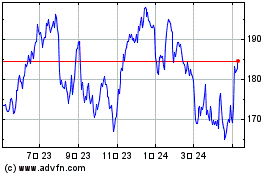By Simon Constable
As recent market action shows, there are perils with investments
that track market-capitalization-weighted indexes -- especially
when a rally goes into reverse.
For example, investors who buy SPDR S&P 500 (SPY)
exchange-traded fund, which tracks the largest U.S. listed
companies, might think their portfolio is diversified. But that is
only sort of true, especially in the current market where the index
is heavily weighted with technology stocks such as Amazon.com,
Apple and Google parent Alphabet.
"The market is more concentrated [in one sector] than it has
historically been," says Todd Rosenbluth, head of ETF and
mutual-fund research at New York financial-research firm CFRA.
That's because the S&P 500 weights the component stocks by
their market capitalization, meaning bigger companies take a larger
share of the index. Given that tech stocks have been on a tear
lately, they now take an outsize portion of the index.
A similar index known as the S&P 500 equal-weight index,
tracked by Invesco S&P 500 Equal Weight ETF (RSP), may provide
more diversification for investors because it is constructed in a
different manner. Each stock has the same weight in the index
regardless of the size of the company. The index gets reset to
equal weight each quarter to take account of the price moves in the
component stocks, Mr. Rosenbluth says.
The pros and cons
There are pros and cons to holding funds that track either type
of index, but here are the basic need-to-know details on each type
of investment.
As of Oct. 30, the tech sector made up 27.4% of the S&P 500
index, while the energy sector represented a near-negligible 2%,
according to data from S&P Global. That means small moves in
the price of Apple and Microsoft will ultimately have a much larger
impact on the performance of the SPDR fund than massive moves in
energy stocks such as Exxon Mobil.
On the other hand, with the equal-weight index, a 5% move in
Apple stock will have a similar impact on the performance of the
index as a 5% move in Exxon Mobil. "There's greater diversification
with the equally weighted fund than there is with the
market-cap-weighted one," says Bob Stammers, director of investor
engagement at the CFA Institute in Atlanta.
With the market-cap-weighted fund, you can get more of the
concentrated exposure to certain sectors just as investors have
seen with tech recently, he says. "As the biggest stocks go up in
value, you get more exposure, and you could have much larger swings
in the value of the index if those largest stocks are volatile,"
Mr. Stammers says. More volatility is exactly the opposite of what
portfolio diversification is supposed to achieve. By holding stocks
in lots of different sectors of the economy, the idea is that when
some areas do poorly, others do better. In short, true
diversification means that you get a smoother ride for your
investments.
Because of the rebalancing methodology, equal-weight indexes
follow the practice of selling a portion of the winning stocks and
buying some more of the underperformers. The idea is that no sector
keeps going up forever. All sectors have bad years where they
underperform the broader index and vice versa.
"I think everyone knows that you should sell your winners and
buy your losers," Mr. Rosenbluth says. "Equal-weight strategy is
similar in nature to rotating into what hasn't worked out on the
assumption that it will come back." Vice versa is also true.
For instance, in 2018, the health-care sector was the best
performer in the S&P 500, with total returns of 6.5% versus a
loss of 4.4% for the overall index. The next year, 2019, it was one
of the worst performers, lagging behind the S&P 500 by more
than 10 percentage points, according to data from CFRA. Or put
another way, selling some of your health-care holdings in late 2018
and investing them in other sectors would have served investors
well.
Cap-weighted fans
However, not everyone sees things that way. Others see the
market-cap-weighted index as better because it follows the winners
and dumps the losers. And in market capitalism, companies that
continually underperform eventually tend to go out of business or
get ditched from the large-cap indexes.
"The S&P is the greatest momentum strategy in the world
because it buys more of the best ones and kicks out the bad ones,"
says JC Parets, founder of technical analysis firm
AllStarCharts.com. Technical analysts, or chartists, look at price
chart patterns to forecast which direction stocks will move.
So which strategy has worked best? It depends on what period you
look at. In one analysis, the total return from April 25, 2003,
through Oct. 26 this year showed that the equal-weight Invesco fund
had annualized returns of 10.5% versus 9.93% annualized returns for
the SPDR fund over the same period, according to Morningstar. The
inception of the Invesco fund occurred on April 24, 2003, so a
longer comparison isn't possible.
If you look at the past 10 full calendar years (2010 through
2019), each of the two approaches bested the other in five of the
10 years. However, in four of the past five years, the
market-cap-weighted SPDR fund has had better returns. That leads
some to believe that a reversal of fortune back to equal-weight
investing being the winning strategy may be in the cards soon.
"When the market-cap-weighted S&P has beaten the equally
weighted S&P, it rarely happens for this big a period," says
Mr. Rosenbluth. "When that has happened, we see the equal-weighted
index catch up."
Mr. Constable is a writer in Edinburgh, Scotland. He can be
reached at reports@wsj.com.
(END) Dow Jones Newswires
November 08, 2020 12:16 ET (17:16 GMT)
Copyright (c) 2020 Dow Jones & Company, Inc.
Apple (NASDAQ:AAPL)
過去 株価チャート
から 3 2024 まで 4 2024

Apple (NASDAQ:AAPL)
過去 株価チャート
から 4 2023 まで 4 2024
